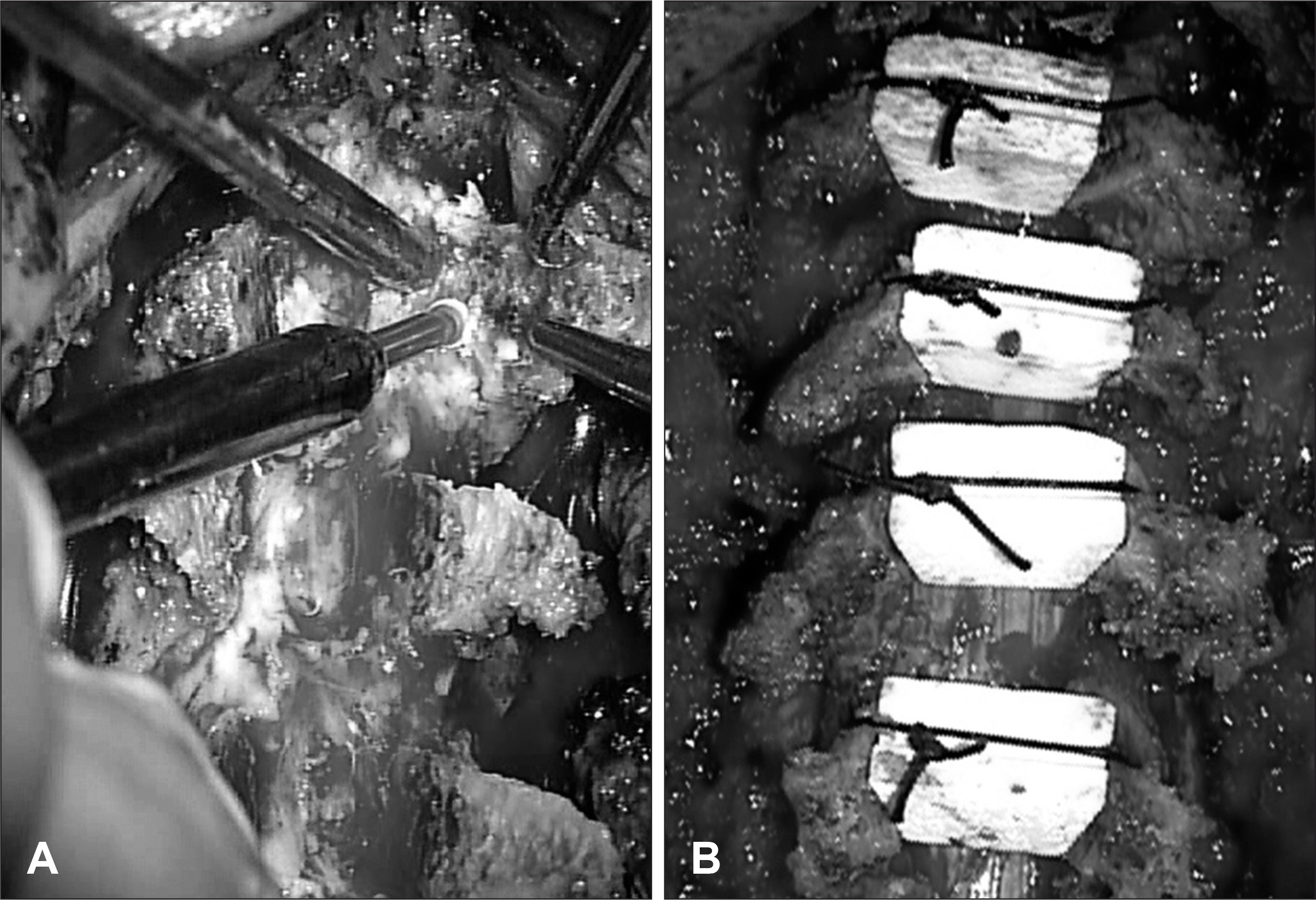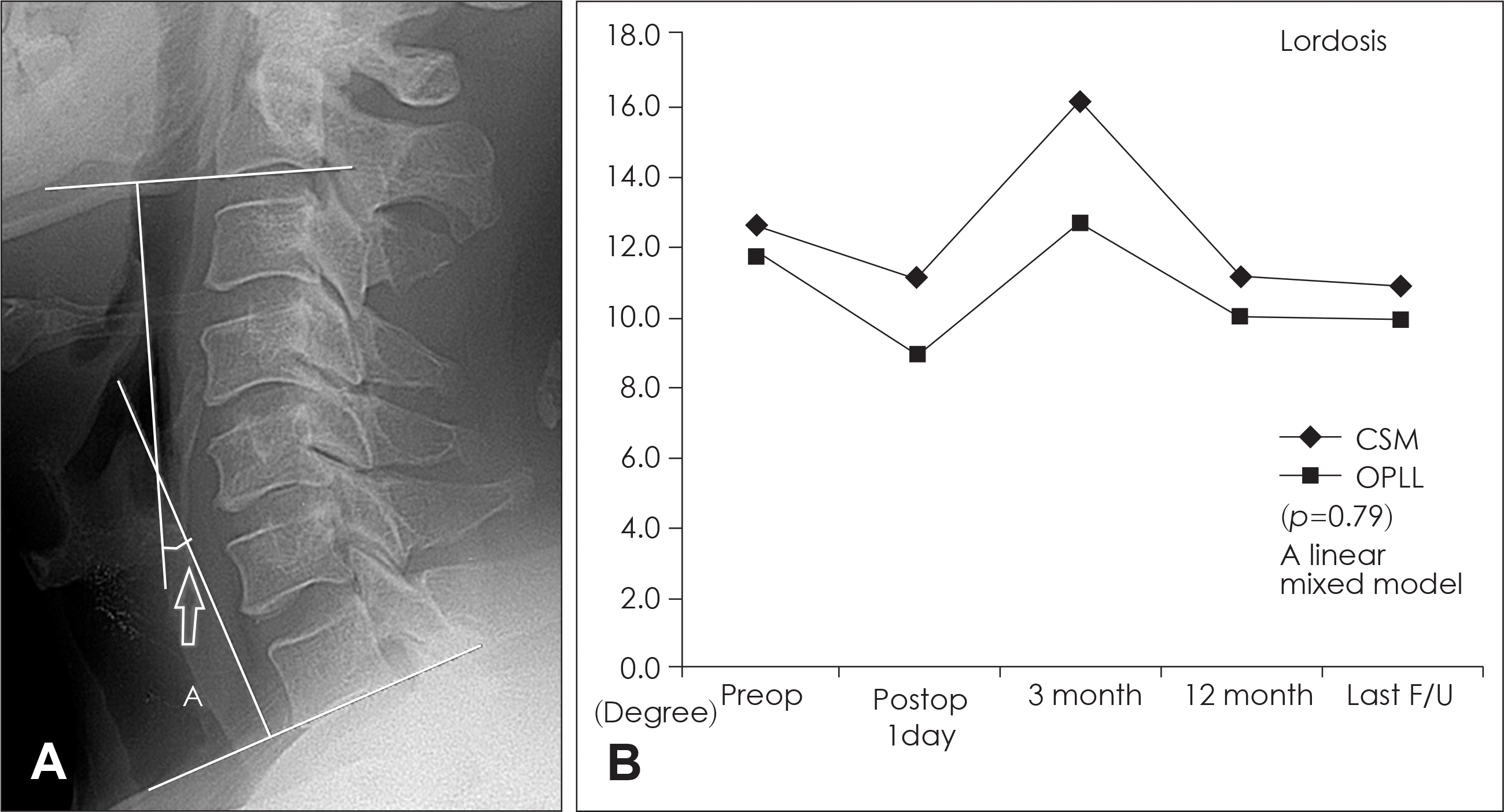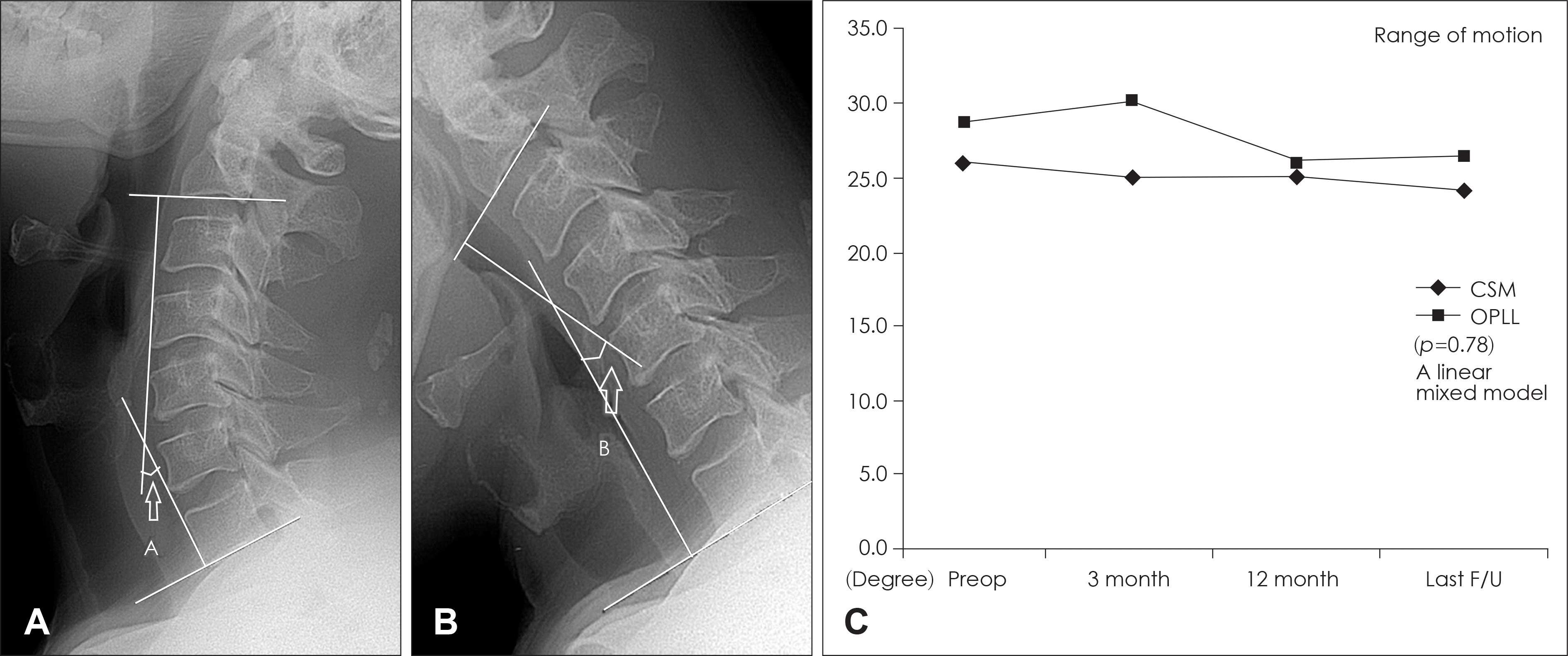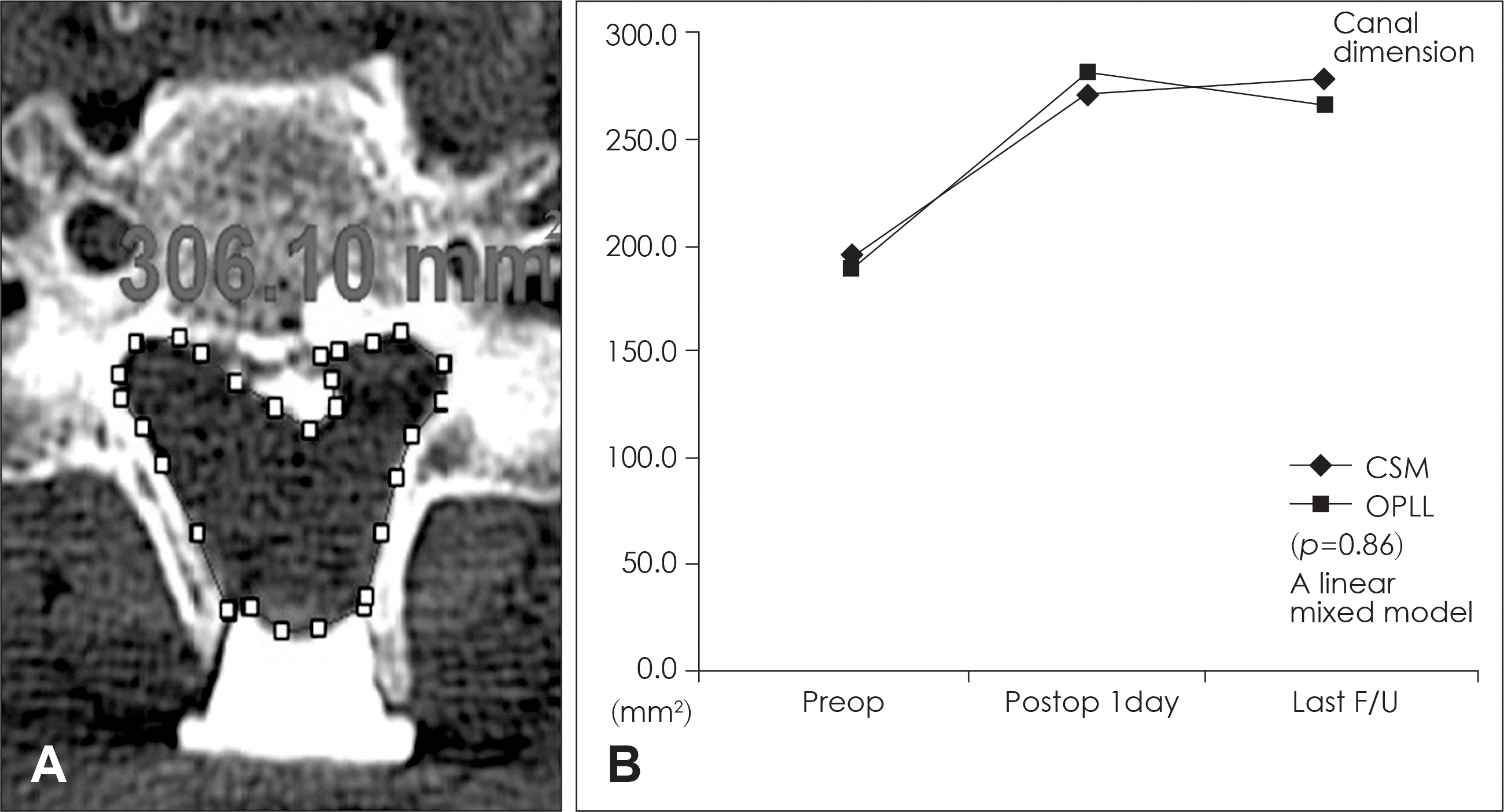Abstract
Objective:
Both of ossification of posterior longitudinal ligament (OPLL) and cervical spondylotic myelopathy (CSM) could be treated by cervical laminoplasty. In this study we compared long-term clinical and radiological outcomes in these two disease entities, treated with modified midline splitting laminoplasty (MSL).
Methods:
We retrospectively analyzed the outcomes of 21 consecutive cervical myelopathy patients (13 OPLL and 8 CSM) who underwent modified MSL between 2004 and 2008. The mean follow-up duration was 49.5 months. The clinical outcomes were evaluated by the Japanese Orthopedic Association (JOA) score and the radiologic outcomes included the change of cervical lordosis, range of motion (ROM) and spinal canal dimension.
Results:
The mean JOA scores of overall patient changed from 6.9 to 11.9, resulting in mean calculated recovery rates of 42.3%. The recovery rates of each group was 38.0% in the CSM group and 45.5% in the OPLL group, respectively (p=0.45). The mean cervical lordosis changed from 12.5 to 10.75 degrees in the CSM group and from 11.76 to 9.84 degrees in the OPLL group (p=0.79). The mean cervical ROM changed from 26 to 24.2 degrees in the CSM group and from 28.7 to 26.3 degrees in the OPLL group (p=0.78). The mean canal dimension changed from 201.1 to 285.0 mm2 in the CSM group and from 198.5 to 284.7 mm2 in the OPLL group (p=0.86).
Go to : 
REFERENCES
1). Chiba K., Ogawa Y., Ishii K., Takaishi H., Nakamura M., Maruiwa H, et al. Long-term results of expansive open-door laminoplasty for cervical myelopathy—average 14-year follow-up study. Spine (Phila Pa 1976). 31:2998–3005. 2006.

2). Hirabayashi K., Watanabe K., Wakano K., Suzuki N., Satomi K., Ishii Y. Expansive open-door laminoplasty for cervical spinal stenotic myelopathy. Spine (Phila Pa 1976). 8:693–699. 1983.

3). Hirabayashi K., Satomi K. Operative procedure and results of expansive open-door laminoplasty. Spine (Phila Pa 1976). 13:870–876. 1988.

4). Iwasaki M., Kawaguchi Y., Kimura T., Yonenobu K. Long-term results of expansive laminoplasty for ossification of the posterior longitudinal ligament of the cervical spine: more than 10 years follow up. J Neurosurg. 96:180–189. 2002.

5). Katsumi K., Yamazaki A., Watanabe K., Ohashi M., Shoji H. Can prophylactic Bilateral C4/5 Foraminotomy Prevent Postoperative C5 Palsy After Open-Door Laminoplasty? A Prospective Study. Spine (Phila Pa 1976) 8, 2011 [Epub ahead of print].
6). Kimura I., Shingu H., Nasu Y. Long-term follow-up of cervical spondylotic myelopathy treated by canal-expansive laminoplasty. J Bone Joint Surg Br. 77:956–961. 1995.

7). Komagata M., Nishiyama M., Endo K., Ikegami H., Tanaka S., Imakiire A. Prophylaxis of C5 palsy after cervical expansive laminoplasty by bilateral partial foraminotomy. Spine J. 4:650–655. 2004.

8). Kong Q., Zhang L., Liu L., Li T., Gong Q., Zeng J, et al. Effect of the decompressive extent on the magnitude of the spinal cord shift after expansive open-door laminoplasty. Spine (Phila Pa 1976). 36:1030–1036. 2011.

9). Kurokawa T., Tsuyama N., Tanaka H., Kobayashi M., Machida H., Nakamura K. Double-open door laminoplasty. Bessatsu Seikeige-ka. 2:234–240. 1982.
10). Nakano K., Harata S., Suetsuna F., Araki T., Itoh J. Spinous process-splitting laminoplasty using hydroxyapatite spinous process spacer. Spine (Phila Pa 1976) 17: S41-S43. 1992.

11). Ogawa Y., Chiba K., Matsumoto M., Nakamura M., Takaishi H., Hirabayashi H, et al. Long-term results after expansive open-door laminoplasty for the segmental-type of ossification of the posterior longitudinal ligament of the cervical spine: a comparison with nonsegmental-type lesions. J Neurosurg Spine. 3:198–204. 2005.

12). Oyama M., Hattori S., Moriwaki N. A new method of cervical laminectomy. Cntrl Jpn Orthop Traumat Surg. 16:792–794. 1973.
13). Sakaura H., Hosono N., Mukai Y., Ishii T., Iwasaki M., Yoshikawa H. Long-term outcome of laminoplasty for cervical myelopathy due to disc herniation: a comparative study of laminoplasty and anterior spinal fusion. Spine (Phila Pa 1976). 30:756–759. 2005.
14). Sakaura H., Hosono N., Mukai Y., Ishii T., Yoshikawa H. C5 palsy after decompression surgery for cervical myelopathy: review of the literature. Spine (Phila Pa 1976). 28:2447–2451. 2003.
15). Tsuzuki N., Zhogshi L., Abe R., Saiki K. Paralysis of the arm after posterior decompression of the cervical spinal cord. I. Anatomical investigation of the mechanism of paralysis. Eur Spine J. 2:191–196.
Go to : 
 | FIGURE 1.A: Intra-operative image showing the lamina inner cortex drilling which was effective for widening of spinal canal and decompression of foramen. B: The modified midline splitting laminoplasty method. Note that the ligamentum flavum was removed. |
 | FIGURE 2.A: Overall lordosis was measured as A. B: The change of lordosis. CSM: cervical spondylotic myelopathy, OPLL: ossification of posterior longitudinal ligament. |
 | FIGURE 3.A, B: The range of motion (ROM) was determined as A-B in the dynamic cervical plain X-ray images (ROM: A-B, A: Measured angle between inferior endplate of C2 and inferior endplate of C7 at cervical extension. B: Measured angle at cervical flexion). C: The change of ROM. CSM: cervical spondylotic myelopathy, OPLL: ossification of posterior longitudinal ligament. |
 | FIGURE 4.A: The dimension of spinal canal was measured as the above method. B: The change of canal dimension. CSM: cervical spondylotic myelopathy, OPLL: ossification of posterior lon-gitudinal ligament. |
TABLE 1.
Basic characteristics of patients in two different groups
TABLE 2.
Clinical outcomes of two groups




 PDF
PDF ePub
ePub Citation
Citation Print
Print


 XML Download
XML Download